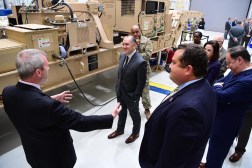Air Force’s JADC2 tests delayed at least two months

The next round of testing of the futuristic technology system that will connect the military’s data across global domains is delayed due to the coronavirus outbreak, the chief of staff of the Air Force announced.
The Air Force is postponing data integration demonstrations for the Joint All Domain Command and Control (JADC2) system until at least June, Gen. David Goldfein said.
The network-of-networks is compared to a military Internet-of-Things (IoT). With such complexity in its interconnectivity, the system relies on testing events where drones, ships, fighter jets, and other military weapons and hardware are brought together to integrate the data coming in from sensors.
Goldfein stressed that the test’s original April date is not being canceled, only delayed to the summer to ensure that work on the system continues.
“It’s really important that we are postponing it and not canceling it,” Goldfein said during a press conference at the Pentagon. “A number of industry leaders are also involved in this.”
The demonstrations will include many private companies contracted to help develop the technology that aims to connect “every sensor, every shooter.” Once data is better integrated, the military can use automation and eventually artificial intelligence for decision-making across the domains of air, land, sea, cyber and space.
The last three-day demonstration in December connected data from sensors on the Air Force’s F-22 and a Navy Arleigh Burke-class destroyer. The tests have been scheduled to occur every four months, a timeline the Air Force hopes to keep despite the virus’s rapid spread.
“We want to get right back on track as soon as the conditions allow us to,” Goldfein said. With the extra time this current delay affords, the Air Force is trying to “advance some of the technologies,” he added.
A new doctrine
As Joint All Domain Operations — the larger strategy that JADC2 falls under for how the military services work more closely across all domains of warfighting — continues to emerge as the plan to address near-peer threats, the Air Force has come out with new doctrine to better present and support the concept.
On March 5 Goldfein signed the 8-page document that defines Joint All Domain Operations, JADC2 and outlined the technology’s use in the Air Force’s future fights.
The goal of having operations across air, land, sea, cyber and space is to achieve a “convergence of effects” that give the U.S. military an edge in a fight with a near-pear competitor like China, the document reads. It is a new way of fighting that will require the Air Force to change how it “thinks and conduct operations.” Military commanders have previously stated the U.S. cannot rely on having superiority in any one area any longer.
The central technical challenge, as laid out in the doctrine, is turning large amounts of data from many sources into “actionable intelligence.” That will mean creating an all-new data architecture, Goldfein has previously said.
“Even a robust JADC2 system will not guarantee continual reachback in a contested environment,” the doctrine reads, referring to the ability to receive intelligence, surveillance, and reconnaissance from sensors. Because of this, all-domain operations will have to rely on less centralized planning, the doctrine states.
The doctrine also gives a new definition for JADC2: “the art and science of decision making that rapidly translate decisions into actions, leveraging capabilities across all domains with mission partners to achieve operational and information advantage in both competition and conflict.”






